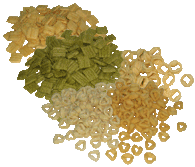
Institute of Food Research and Product Development, Kasetsart University
| “Snack food” is a type of food that is not meant to be eaten as part of one of the main meals of the day (breakfast, lunch, supper). Rather, the food is intended as a snack : something to temporarily tide a person’ s hunger and provide a brief supply of energy for the body. The market for snack foods is enormous, growing fast and generates highly income for each year. Snack foods are advertised to capture larger shares of the snack food market. Heavy promotions such as the flashiest TV commercials and advertising campaigns are often desired to sell snack food.
Snack foods are designed to be less perishable, more durable, and more appealing than natural foods. They often contain substantial amounts of sweeteners, preservatives, and appealing ingredients such as chocolate, peanuts, and specially designed flavors. Nevertheless, taste and nutrition represent the two most important reasons consumers choose a particular food item, most producers should produce snack foods by enhancing flavor, texture, and increasing a healthful image Primarily, snack foods are often classified as junk food : they have little or no nutritional value, and are not seen as contributing towards general health and nutrition. But nowadays most people are making a conscious effort to eat more healthy and natural snack such as fruit, vegetables, nuts and cereal grains for growing concern with nutrition, diet, weight control and general health. Consequently, our researcher team in extrusion field of IFRPD (Institute of Food Research and Product Development) tried to develop new health benefits for extruded snack food such as “brown rice snack”, “high-iron extruded snack” and “rice snack with Mulberry leaf” as follow. “Brown rice snack” was held by our research team at IFRPD due to high nutritive value and important Thai agricultural raw materials of brown rice. In this research, Thai brown rice from two varieties with different amylase content (Patumthani 1 and Supanburi 1) were investigated for basic raw materials in the production of direct expansion extruded snack by twin screw extruder at varying feed moisture and screw speed. The brown rice extruded snack from this research gave the most preference in texture and overall acceptance with good condition for health in nutrition labeling. Accordingly, Thai agricultural raw materials have value added by producing enjoyable crispness texture and nutritious of extruded snack which benefit for increasing consumption of snack from Thai brown rice utilization “High iron extruded snack” was carried on by our research team at IFRPD due to improve iron content in snack food for preventing iron deficiency anemia in high risk group, Thai children with ages between 6-14 years. Lack of iron may also lead to unusual tiredness, shortness of breath, a decrease in physical performance and learning problems in children and adults, and may increase your chance of getting an infection. The basic raw material in this research is Thai brown rice which have specialty cross-breeding for high iron enrichment by integrating biotechnology in developing rice strains. However, iron fortificant such as ferrous sulphate, ferrous lactate and ferrous fumarate were added in the extrusion process to produce a high nutritional quality (high iron snack) that can be useful in nutritional programs against anemia and malnutrition.
“Rice snack with Mulberry leaf” is also carried on by our
research team at IFRPD with the purpose of using natural antioxidant
from Mulberry leaf to develop new health benefits in snack products.
The mixture of raw materials will be mixed with dry matter of Mulberry
leaf and feeding into the twin screw extruder. Apart from nutritional
enhancement such as antioxidant activity and dietary fiber, the
aimed product will get natural green color and new taste from Mulberry
leaf.
|
